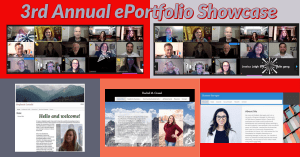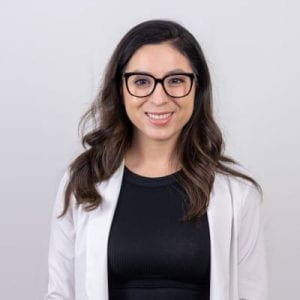The positive energy reverberated around the globe with participants as far away as China and Qatar tuning in virtually for our 3rd Annual ePortfolio Showcase.
 The occasion: Honoring the Corporate and Organizational Communication graduate students who created the most compelling digital portfolios in the 2019-20 academic year.
The occasion: Honoring the Corporate and Organizational Communication graduate students who created the most compelling digital portfolios in the 2019-20 academic year.
Why a digital portfolio can bolster career advancement
This year’s showcase kicked off with insightful career tips from Jeffrey Yan, Co-founder and CEO of Digication, which is the company that developed the platform we use for our digital portfolios. Yan congratulated the night’s honorees noting, “The ePortfolio is your story, it’s your personality, and your passion, it’s what makes you special and makes you stand out.”

Based on his years of experience in the marketplace for talent, Yan shared these observations:
- Surveys show that 80% of hiring managers view a strong digital portfolio as more useful than any sort of transcript or resume in determining a candidate’s potential.
- To maximize awareness, it’s important to insert a link to the ePortfolio in one’s email signature and social media channels, especially LinkedIn.
- Since students have access to their ePortfolio’s after graduation, Yan suggests they fine tune them for multiple situations, including a version targeted at a specific employer or sector.
Selecting the top portfolios
Since more than 100 students created ePortfolio’s last year, selecting the top 3 was a daunting challenge! Nine of our alumni volunteered to serve as judges, reviewing a smaller group of faculty-nominated portfolios.
In rating the ePortfolio’s, the judges considered the following three criteria:
- The degree to which the student reflected on their course learnings and connections across the curriculum.
- The use of design, writing fluency, and creativity to draw readers into their stories.
- And the connection between coursework, on-the-job experiences, and professional networks.
The ratings were tightly bunched, but the judges identified three stellar ePortfolio’s.
Congratulations to Elizabeth Barragan, Rachel Cossel, and Stephanie Leandri!
Here’s what the judges had to say about our honorees:
 “Elizabeth Barragan seamlessly melded her academic, professional and personal lives into a compelling and engaging portfolio. Through her words and photos, I learned about Elizabeth’s values which inspire her current professional work and future goals.” Click here to take a tour of Elizabeth’s ePortfolio.
“Elizabeth Barragan seamlessly melded her academic, professional and personal lives into a compelling and engaging portfolio. Through her words and photos, I learned about Elizabeth’s values which inspire her current professional work and future goals.” Click here to take a tour of Elizabeth’s ePortfolio.

“Rachel Cossel’s portfolio is so engaging! Excellent organization, fantastic visual experience. Great storytelling, many personal touches that provide the reader with a holistic sense of who she is. I really love the inspiring messages that she conveyed. I want to get to know her!” Click here to experience Rachel’s ePortfolio.
 “Stephanie Leandri provided a well-rounded description of her educational and professional history. The Professional Journey section was especially effective at conveying the story about her personal experience, while still connecting it to her broader professional interests and goals.” Click here to go on Stephanie’s learning journey.
“Stephanie Leandri provided a well-rounded description of her educational and professional history. The Professional Journey section was especially effective at conveying the story about her personal experience, while still connecting it to her broader professional interests and goals.” Click here to go on Stephanie’s learning journey.
What does it take to create a compelling ePortfolio?
Our honorees shared some great advice for students in the throes of creating a digital portfolio.
The first bit of advice: Don’t wait until the last minute to work on your portfolio! Stephanie suggested that students take notes after each course, reflecting on the key points, and then revisiting the notes at the end of the program. Uploading signature assignments at the end of every course is a major time-saver.
Everyone agreed that our program’s ePortfolio template is easy to use and allows students to express their creativity with photos, videos, and other multimedia. Elizabeth, for example, decided to use photos of her team at work because they conveyed the type of organizational culture she thrives in.
Since the ePortfolio is intended to convey every student’s unique story, the chapters of the story can be unique as well. Rachel, for instance, included sections on her volunteer work and her family because both are an essential part of who she is as a communicator.
And what should you do if you get stuck? Rachel confessed that the first section she designed was the ‘Contact’ page – she could experiment with design elements, images, and wording. Start small!
Congratulations to our honorees!
Posted by Kerry Murphy and Carl Zangerl